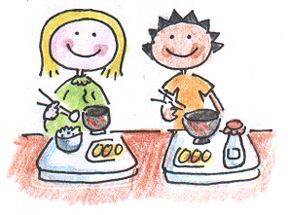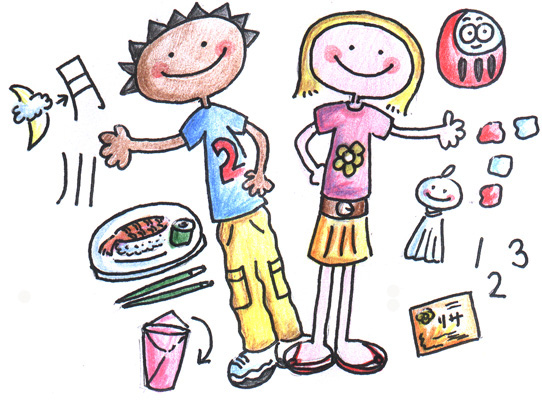Lesson 7
Lesson Plan Download pdf
Main (40 minutes)
Hold up a banana (or similar) and say:
| banana o tabemasu. | バナナを食べます。 | (I eat a banana) |
Take a bite and then ask the children: “What do you think I’m saying?” I eat a banana. To re-inforce the structure, ‘noun o tabemasu’, repeat the sentence another 5 times and also have the children repeat back, paying careful attention to pronunciation.
To create a more Japanese flavour, you could bring in a ‘kibidango’ (millet dumpling) and make reference to the kibidango that Momotaro gave away to the animals (Lesson 6).
| kibidango o tabemasu. | きびだんごを食べます。 | I eat a dumpling. |
Dumpling recipes are as follows:
https://www.japancentre.com/en/recipes/693-three-colour-dango-dumplings
https://www.thespruceeats.com/mitarashi-kushi-dango-2031131
The same sentence (noun o tabemasu) could then be continued using various different breakfast foods known to the children, such as:
| Frosties o tabemasu. | フロスティーズを食べます。 |
| Weetabix o tabemasu. | ウイータビックスを食べます。 |
| toast o tabemasu. | トーストを食べます。 |
| Coco Pops o tabemasu. | ココポップスを食べます。 |
Then take a drink of orange juice and say:
| orenji jusu o nomimasu. | オレンジジュースを飲みます。 |
“What am I saying this time?” Pass round an empty cup and children repeat.
Make reference to the fact that although Japanese uses many loan words from English, they are pronounced slightly differently (refer back to the sports learned in lesson 5). This is because Japanese doesn’t have all the sounds that English does. Have the children listen and repeat carefully as you say the words. Can they identify any patterns?
Hold up flashcards of various different foods and drinks and have children identify the correct verb: ‘nomimasu’ or ‘tabemasu’. Use the food and drink presentations to show images of Japanese cuisine. Also use the background Culture Notes accompanying this lesson.
What is origami? (traditional art of paper folding - for more origami links, check out: http://www.origami-club.com/). Has anyone ever made anything out of origami before? Explain that today, children will fold themselves a paper cup, taking care with the folds and considering angles, parallel and perpendicular lines. Tell the children that if they are careful, then they can actually drink from these cups! Demonstrate how to do the folds using the worksheet to assist.
Once completed, repeat the sentence learned during the starter and children can ‘choose’ which drink they are having, such as:

| kohi | コーヒー | coffee |
| ocha | お茶 | green tea |
| kora | コーラ | cola |
| karupisu | カルピス | Calpis |
| kohi o nomimasu. | コーヒーを飲みます。 | I drink coffee. |
(Again, use the drinks presentation/flashcards accompanying this lesson for pictures of various different beverages).
How do people eat their meals in Japan? Explain that although knives and forks are commonly used when eating Western food, chopsticks are often the preferred utensil. Hand out pairs of waribashi (disposable chopsticks) to each of the children and demonstrate how to hold them. (Waribashi can be bought from any Japanese or Chinese supermarket – your local takeaway may even donate some, although be aware that the shape and length of Japanese and Chinese chopsticks are slightly different. Alternatively, try Wing Yip: www.wingyip.com/ or the Japan Centre www.japancentre.com/en)
Give children a pile of dried beans or pasta shapes and have them pick them up one at a time and count them into their origami cup (in Japanese!) Once they have practised, perhaps a small competition could be held to see who can pick up the most beans in a set period of time! Children should also practise saying the following:
| pasta o tabemasu | パスタを食べます | I eat pasta |

